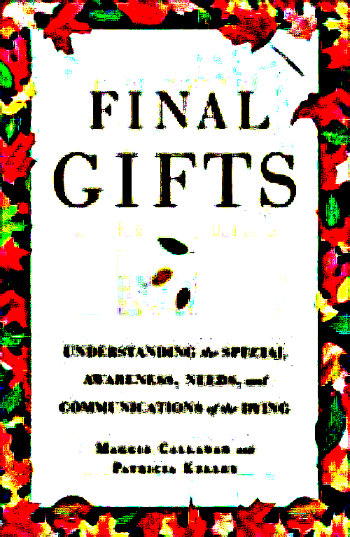Final Gifts

I was recently loaned the book Final Gifts: Understanding the Special Awareness, Needs and Communications of the Dying by nurses Maggie Callanan and Patricia Kelley. This is a book about hospice, how people can “gain the insight and understanding you need to find something good in the sadness and pain of losing someone you care about”. (Callanan & Kelley, p. 6) The authors shared that their hope was not to provide research but rather to share stories that will increase the appreciation of the messages about dying.
The book is divided into 3 parts: Nearing Death Awareness (Introduction and Background); Nearing Death Awareness (What I am Experiencing); and Nearing Death Awareness (What I Need for a Peaceful Death). Their explanation of the
use of “Nearing Death Awareness” is that it is a “special knowledge about – and sometimes control over – the process of dying”. The book is about people dying slowly, describing their experiences, and the needs they have expressed for what they need and want to die peacefully. This is not about “near death” experiences, but rather the stories, observations, and sharings of those who know they are dying, those caring for those dying, and those assisting in the palliative care of those dying.
Our view of death has somehow evolved; since 1960’s there has been a movement from a “hands-off” approach, to one
where hospice is invited in, with the patient electing how and where to die, often in their own homes, if possible. Dr. Dame Cicely Saunders, who opened St. Christopher’s Hospice in London in 1967 said, “You matter because you are. You matter until the last moment of your life, and we will do all we can not only to help you die peacefully but also to live until you die.” (Callanan and Kelley, p. 24) The book tied together the work of Saunders with that of Elizabeth Kubler-Ross and her stages of death, discussing how those are acted out within a hospice situation. The authors wrote about reconciliation, patients telling about being stuck between two worlds, about recognizing the nonverbal communication, the part spirituality may play, and being aware, both of the patient and the caregivers, of the dignity of choice and the ability to savor the time spent with the one dying. The latter part of the book is “Practical Uses”, a guide of sorts, focusing on the dynamics of entering into caring for a loved one, facing your own fears, and being very appropriate as the dying person comes into a new awareness.
The book is loaded with personal stories, which add to the personal thread of understanding the awareness that is revealed during the process of dying. The stories are handled reverently, with much honor of the families who shared or witnessed or experienced the approaching death of a loved one.
In the cycle of life, allowing people the dignity of dying at home, sharing their awareness, and being comfortable at the end of life seems more dignified and very honoring of the lives led. Those sharings are the “final gifts” left by the dying, for the living.
Works Cited
Callanan, Maggie and Kelley, Patricia. (1992) Final gifts. Bantam dell/Random House. New York, NY
ABOUT THE AUTHOR

Deb England
Licensed Independent Mental Health Practitioner
Licensed Professional Counselor
Advanced Clinical HypnoTherapist- Deb England began working part-time for Wholeness Healing Center in September 2004 and began full-time in May 2005. Deb practices primarily in the Broken Bow office and one day a week in the Grand Island office. Previously she had completed her practicum and internship at Morning Star Alliance, working in the Broken Bow and Grand Island offices.
LATEST ARTICLES BY Deb England
- Traffic Stop: Human Division, a Book Review
- The Shadow Effect: Illuminating the Hidden Power of your True Self, a Book Review
- Adjunct Modalities Round 3, Rocks, Gems, Crystals and More
- Adjunct Modalities: Round 2, Reiki Opportunities
- “Aging: not necessarily a goal but just what happens in life. Can’t change it. Can’t stop it. Can’t even prolong it.“
Subscribe today
Sign up to receive the latest mental health tips and inspiration